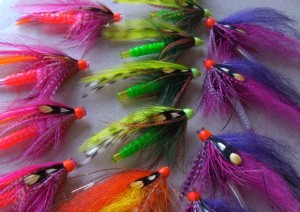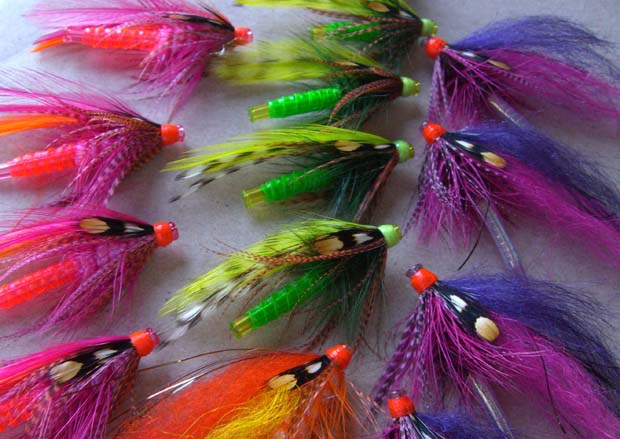Tube flies were invented by Pacific Northwest Native Americans, then born anew in Europe in the late 1940s. . . a several hundred year gap
[dropcap]I[/dropcap]n modern times, tube flies have been a part of the offshore big game fly fishing scene for quite awhile. The advantages over hook tied flies is very obvious.
The offshore billfish fraternity is for the select few that do not blink at a $45,000 dock fueling charge in Guatemala. Think Yachts. The simplest reason for tube flies’ success offshore are its universal benefits that occur in any fishing situation. One, deny the fish leverage; two, under size the hook for better penetration, three; change orientation of hook at any time; four, change-out the hook at any time and lastly use any size fly without reservation governed by the hook length/size/weight.
Modern tubing
For Europeans, tube flies have been part of almost everyone’s everyday-go-fishing diet and for decades. Tubes in Europe are employed to attract everything from carp, salmon, trouts and catfish.
The Swedes and Danes lead in all advances with regard to tube fly technology, especially so with materials. Most of what we buy in tube accoutrements have a European origin. NOTE: Dane / Swede flies a decidedly more compact (smaller) but “fatter.” Their belief is motion and commotion better produces a strike.
Additionally, these Nordic lads and lassies are very comfortable with 10-foot rods but do not invoke “switch rods.” In their use description of fly casting these 10-footers it is undeniably a SWITCH rod they are talking about.
Are the Yanks and Canucks coming on strong with regard to adopting tubes?
 Well, yes and no. In the American West and Canadian West, as well as Alaska (last dozen years), tube flies have become breakfast, lunch and dinner since reaching immigrate status from Europe. For the rest of the country, with the exception of the Great Lakes fishery (salmons and steelhead) and the New England striper area, tube flies are at best a novelty.
Well, yes and no. In the American West and Canadian West, as well as Alaska (last dozen years), tube flies have become breakfast, lunch and dinner since reaching immigrate status from Europe. For the rest of the country, with the exception of the Great Lakes fishery (salmons and steelhead) and the New England striper area, tube flies are at best a novelty.
Ask someone east of Montana about tube flies and he or she might come up with, “They are OK for salmon and steelhead.” Taking it a bit further…suggest using tubes for trouts and you can see the bubble speak: “This guy is nuts.” But most times it is a speechless – deer in the headlights look.
Press the subject by suggesting tubes better aid fly fishing for trout, flats animals (sea trout, bonefish, permit, snook and redfish), near offshore species (cobia, tripletail, mackerels like king, Spanish and cero), carp, bass (largemouth, smallmouth, hybrid, white, spotted or stripers) than hook-shank tied flies and you probably lose your listener/reader.
Personally, I have never heard of tube flies being championed in the Northeast U. S., mid Atlantic or South by a single fly shop, manufacturer, guide, product rep, fly tyer or industry scribe. Does that mean they are not known in those regions? No – just that I have not heard many yes replies to tubes, or any sense of all-in.
Advantages
On a shank tied fly a head shake will allow the fish to use leverage and spit the hook. With conventional shank tied flies, should your quarry need to be enticed with a sizable meal, the hook size may become negative, as in way too big and way too heavy to cast and perform as an enticement. A long shank hook almost always works as a “hook remover” when the hook-set is at a particular angle in any pescados’ mouth.
An oversize tube fly does not mean an oversize hook or heavy – an undeniable advantage. A smaller hook on a large tube fly will hook more fish. You can simply use any hook you want and use any orientation you want. If a hook change-out is called for (smaller, larger, different shape, orientation or damaged) you do not need a new fly. Just choose a new hook, tie it on and start fishing.
Personally, I only use chemically sharpened hooks, which are generally reserved for freshwater. Will that hook fail in the salt? Yup, but just get a new, razor sharp one if a sign of rust shows. Will I use that kind of chemically sharpened fresh water hook on big animals? No. But I can still have a huge fly and a small saltwater hook.
Tom Rosenbauer
Rosenbauer is a very influential Orvis exec and fly fishing personality. He expresses positive feed back regarding the use of tube flies in the New England striper fishery, but limits “tube” potential by the absence of a wider commentary. To read his experience, as printed by Fly Fisherman, click here . . .
April Vokey and “Stacking”
A distinct advantage with tubing, and playable in any venue, is stacking. The latter is literally impossible with hook tied flies. Stacking is simply stringing multiple tubes together. A gurgler, for example, could not be stacked using conventionally tied flies because the fly would sink – undermining its function and purpose.
Vokey stacking interpretation can be read here . . .
Martin Joergensen
There does not seem to be a good reason to refuse tube flies according to Martin Joergensen, editor and developer of The Global FlyFisher. The latter is an online blog/newsletter devoted to fly tying and fly fishing. It has more than a slant on tube fly tying, tying techniques, fly fishing tubes, tube material technology.
Joergensen is an avid fly tyer and fly fisher. His articles have appeared in many international fishing and fly tying magazines and he has written about fly tying and fly fishing – publishing in both Danish and English. He has appeared at US tying shows and speaks often on the subject of tube flies, fly tying and fly fishing.
To find out what the nordic legends think of tube flies, go here . . .
HMH, an all-in supplier of tubing materials, flies, accoutrements
Here is their take on why you should use tube flies:
1. Tubes give you more control over the weight of your fly. By simply changing up the type of tube your pattern is tied on, you can have the exact same fly with dramatically different weights.
2. With tube flies, it is possible to take an already great hooked pattern and make it either wider and/or longer. Often a fly with a bigger profile can make all of the difference.
3. Tube flies land you more fish. Since thetube usually detaches from the hook, the shorter shank makes it tougher for a fish to thrash it out.
4. Tube flies are extremely reusable. The fly usually slides up the line when a fish is hooked. That way no fish teeth actually touch the feathers and fur.
5. Tube flies are very adaptable. That is to say, you can easily change the hook size of the fly to accommodate whateverspecies you are fishing for.
6. Tube flies can also be combined with beads, spinner blades and spacers either in
front or behind. This gives you more possibilities.
7. Tube flies are not exclusive to fly fishermen. Many of our customers troll these flies on spin tackle. They are also often used to “bucktail” in salt water.
[information]The Canadian Tube Fly Company
6816 11 Ave
Edmonton, Alberta,
CANADA
T6K 3J5
canadiantubeflies@shaw.ca
1-800-572-7493


